The T-Cup Principle
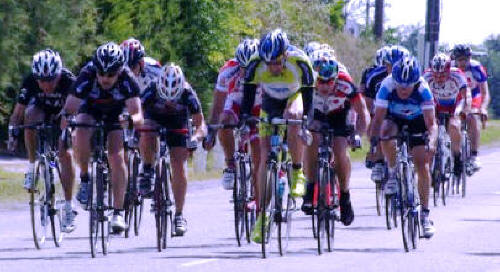
To think, or not to think? That is the question...
This factsheet is an offshoot from the rather in-depth, double header factsheets of Hope is Not a Strategy. It covers possibly the most important part of a champion's attributes armoury, their mindset. And as ever, there's another acronym for you to drop in to your local weekend chain-gang, T-CUP; thinking clearly under pressure.
This is the one attribute that can make or break all the physical and physiological preparation that you've spent six months sweating over. Please read this page very carefully as this is the stuff that will allow you to move to the next level of your sporting ladder.
It matters not how well you are prepared physically, without a mind that can give clarity of thought to protect, guide, and lead it, your body is going nowhere. Probably quite fast, but no where all the same...
Thinking As An Instinct
This was another of my "working world" favourites. A days
management course I designed to help people sort the wheat from the
chaff in the maelstrom that is now the modern day working office.
We all think; most of us do it most of the time. Some are better at it than others and some can have blistering thoughts one day, and mediocre ones the next. Clarity and consistency are not as prevalent as you may think.
One of the many times non-cycling humans appear to lose rational thought is when they get behind the wheel of a car. But we'll save that discussion for another day!
 You'd
probably be very surprised at how ordinary, rational, level headed people react once
pressure is applied. Even at the top levels of sport and
industry.
You'd
probably be very surprised at how ordinary, rational, level headed people react once
pressure is applied. Even at the top levels of sport and
industry.
In a previous career, I was involved in creating and delivering business disaster continuity scenarios.
During event simulations we often had to stop proceedings and call "time outs", to allow "captains of industry" to re-compose themselves.
The tension, and stress, was often palpable and on
more than one occasion we thought someone was going to have
(or was having) a
panic attack.
Even though these things were carefully controlled "make-believe" simulations (that's all they were, all were held in a hotel conference room somewhere) the fear, stress and anxiety caused were as real as though the building we were in had caught fire. How can this be?
Well it happens because for most people, their emotions cannot tell the difference between reality and make-believe. The body believes what the brain tells it. Your body reacts to your brain's output. And your brain's output is not necessarily the same, or related to, the input it is receiving from your five (six for women?) senses.
That's how horror movies ratchet up the tension. It's not what's on the screen that frightens you, it's what's in your head. Your head will fill in the blanks, and not always in a good way.
If people can become debilitated to a point of inaction during an event simulation, why should the untrained body and mind react differently to a real situation, be it at a business or sporting level?
Decisions Decisions...
Our internal decision making takes place in the prefrontal cortex of the
brain. Coincidently, this is also the area of the brain that moderates our
external social behaviour! It doesn't like stress; it's easily
overwhelmed.
I did a lot of work on this in the 90's and nothing has changed much in our evolution since then (except for development of the texting thumb muscle), so I'll share some of it with you here. It's relevance to cycle competition is spookily uncanny.
Our brain can only "process" around seven pieces of information at a time. This can be proved in a very, very easy and repeatable classroom test that takes around ten minutes.
You may think you can do more, but trust me, you can't. When the eighth "track" comes in, one of the least important of the current seven being used, from a survivability viewpoint, gets dropped from the pack.
This is why mobile phones, ipods, sat navs, modern dashboards, the explosion in road signage, traffic calming, traffic volumes, etc, push car drivers over the cognitive limit of incoming info that used to be manageable until a few years ago.
When I was learning to drive all we had to look at was the road, a speedo and two lights for the oil and battery! A racing car has even less.

pre-season testing Deer's Leap, Oulton Park
Forced Errors
My old racing car instructor used to say, "if there isn't a
gap, make one". Now this isn't as nefarious as it sounds!
It wasn't meant as an excuse to punt someone off the track, it was
an invite to "overload their sensory inputs". Which is an
other term for "make yourself busy" behind them, flooding their
mirrors with information. Or stick your car up the inside so they
can't see you and have no information
on which to base a decision.
The objective being, to distract, or overload their sensory system to force a missed braking point, apex, or gear change. Sitting behind someone, waiting for them to make a mistake, ain't gonna win you a race.
So what's this got to do with cycling? Everything!
Attacking off the front, is a strategy doomed to failure. Waiting for it all to calm down before making a move is, again, unlikely to prove successful. Your best chance of making something happen is to go when there so much happening no one is quite sure what, or how, it happened.
Your objective, is to gain the experience to know when to stay calm and the rationality to go when it's all kicking off.
If there isn't a gap...
As more data enters the mind at the speed of light, attacks, bunch movement, feeding zones, road furniture, riders encroaching from another team etc, our brains begin to shuffle, and prioritize information according to pre-set and pre-conditioned, templates.
The brain can only run on glycogen. This explains why most "poor" decisions (and crashes) come at the end of the race (or working day) when stress exponentially escalates and blood sugar begins to drop.
As blood sugar drops, the ability to handle the tracks of information diminish. It might be that you can only process six, or five. You're now unable to handle the information presented to you and you start juggling.
It's during one of these "information juggles" that a braking point is missed, a wheel is clipped, you leave a gap up your inside while you look over your outside shoulder. Either way, it's game over.
This is why you always take a caffeinated gel in the last 20 k of a big endurance event or a hard race. You may not need it for a physical response, but it will help you mentally.
As pressure builds, or is perceived to build, the brain automatically goes to its pre-conditioned, default, survival response. Ordinarily, you have no control over this process, it will happen. The brain WILL distribute energy to where it "thinks" it is needed most.
All valuable, and available, resources are diverted to the self-preservation area of the brain, the amygdala. The bit that looks after our fight or flight response. Either of these two options might not be the best answer to your current dilemma.
Obviously, with a limited and diminishing energy resource to power up the amygdala, something has to be powered down. Yep, the decision making prefrontal cortex. Marvelous!
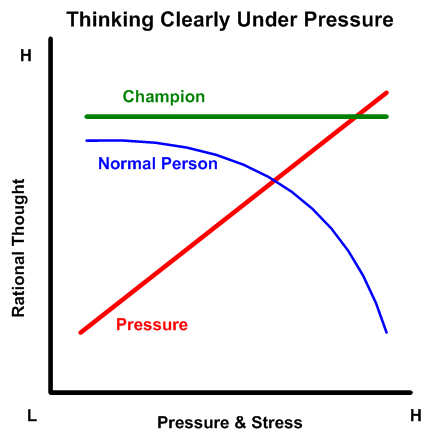
conceptual diagram of stress v clarity of thought
As you can see above, as the red line of perceived pressure and stress increases, the rational thought of a normal person (car drivers?) decreases. But you can see that the thought patterns of a champion, remain clear, constant and focussed, no matter what levels of external stress are applied.
Like it our not, our survival instincts have genetically forced our brains to become hard-wired to prioritize negative information over positive. Positive information isn't going to kill us.
Neither is most of the negative information we receive, but the brain doesn't know that until the prefrontal cortex has processed it. But when the pressure is on, it can't, because the bloody thing has switched energy pathways to the amygdala! How ironic!
So there we have it. A perfect storm for poor decision making under pressure. Or is it?
How come the green "champion's line" remains constant? How come, as Kipling succinctly put it, they can "keep their head when all around them are losing theirs"? What's going on?
Luckily for us, knowledge is the antidote to fear. Remember, the opposite of fear isn't bravery, it's stupidity!
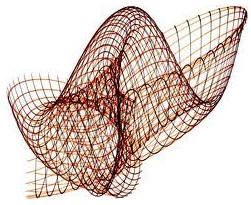 We can't stop our brain from switching resources when it perceives
stress levels are becoming unmanageable. But the big clue, in
our journey to champion status, is in the word "perceives".
We can't stop our brain from switching resources when it perceives
stress levels are becoming unmanageable. But the big clue, in
our journey to champion status, is in the word "perceives".
In the same way that politicians (and Microsoft) often "redefine" what we thought we understood to be "the standard", we can, with exposure and management strategies, delay as long as possible the brain's "perception" of excessive stress.
It's all to do with knowledge. We just need to re-map the information coming in, or stop it getting there in the first place. Don't overload your brain with spurious information. Block out "white noise", let the others worry about it. Your job is to produce it for them to process. Another of our infamous flamme rouge mantras is, "if you're not sure what to do, make a nuisance of yourself!"
You Don't Know What You Don't Know..
US Defence Secretary, Donald Rumsfeld, once got his tongue tied over this
concept trying to bend
it to suit a "knowledge situation". But in effect, it's really
quite simple when you apply it to riding a bike!

You start in quadrant A as a three month old baby. You don't know that you can't ride a bike, because you don't know what a bike is! You are "unconsciously unable". You don't know what you don't know.
As you get older, you see bikes, but realise you can't ride one. You are now three years old; you now know what a bike is and you now know that you don't know how to ride one.
Your older sibling has a bike they can ride and you want to have a go, but you are painfully aware that you are unable to do so. You are now slap bang in the middle of quadrant B.
You are now five years old and can ride a bike. Yeehhhaaa...! But it takes a lot of concentration and you are a bit wobbly. But if people leave you alone you can do it, for the most part, quite safely. You know you can ride a bike because you're doing it. You're in quadrant C.
Finally, you are a "mature", grown adult. You have been riding for so long you've forgotten how you do it, it just happens. You can talk, eat, ride no hands, "switch off" and disappear in your thoughts on long sunny days and the bike just keeps upright and going forward.
You are now "unconsciously able". You've gone full circle. You do what you do without even thinking about how it happens. Quadrant D is where it all comes together.
You need to reach this state of "being competent without thinking" at a level higher than just riding a bike. It needs to work at a level whereby things just happen because they should. As I've said before, if you have to think about it, it's too late.
Champion's Mindset
Your objective to become a champion will not be solely determined by
your physical attributes. Until you do with your brain, what
you do with your body, you will be at the mercy of your unconscious
acts.
Carl Jung (I think he rode for Telecom?) coined it best when he said, "until you make you unconscious conscious, it will direct your life and you will call it fate." Champions have no room in their life for fate.
This may seem contradictory to the above diagram, but what it means is that once you are aware of your unconscious negative thoughts or acts, you can take action to stop them. When you can stop them without having to think about stopping them, you reach a heightened state of awareness, you become, as our American friends say, "in the zone".
You need luck to be a champion, but you don't get luck by waiting around for it to come to you. You get luck by eliminating all of the thoughts, actions and decisions that contribute to bringing "bad luck".
Your actions need to happen faster than consciousness itself. As I keep saying, if you have to think about it, it's too late. It there's a break going, an attack being set up by a rival team, or a feed station approaching, expect something to happen. Don't wait for it to happen then try to decide what to do.
If you find yourself suddenly surrounded by a group of race jerseys that are all the same, you're being blocked in! An attack is imminent, get yourself safely, out of there as quickly as possible. And how did you suddenly become surrounded? These things don't just happen; pay attention to every single move that looks out of the ordinary.
Don't sit there, oblivious to the facts, get back to the finish and say "had a bit of bad luck, I was boxed in". You were boxed in because you allowed it to happen. You missed the signs.
The clues were there, but you were more worried about clipping the wheel in front of you, or trying to decide if you should eat your food now or later? Don't think, act. And always be switched on to the race, nothing else. Everything else is a distraction that's trying to stop you winning.
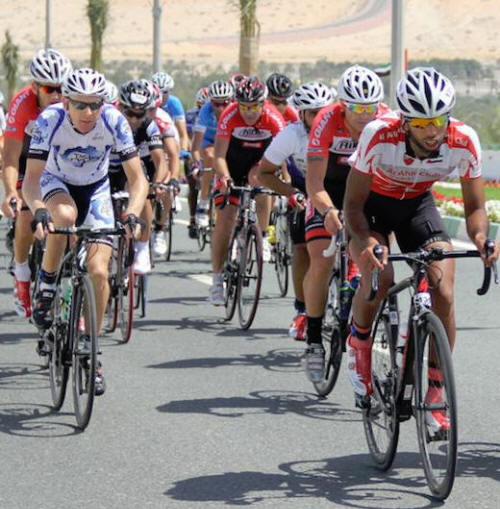
Ian Partridge (centre ~ black/red
helmet) Team Ride GMS Powered by Giant
taking an Open 8th Place in the Liwa Cycling Challenge ~ Abu Dhabi
Temperature? 43 degrees! Keep cool, think clearly, take
the prize.
Managing Information Flow
Your objective is to control the input of information by mapping it
against your experience and pre-defined templates. By cutting
down the input of extraneous information you can keep the pathways
clear for information that leads to a race winning decision.
Impulsive reactions are not conducive to a championship winning ride. Impulsiveness is a product of internal emotion, your external behavioral output should be a product of your experience-led decision making. It's the ability to separate the two that leads to infinity and beyond.
By controlling perceived stress levels, you can also delay the brain switching it's blood supply and electrical impulses to parts of the cerebrum that aren't going to help you.
You need to control the emotional part of the brain and release the rational part of the brain to act freely. It's not as simple as pushing the switch in the blue graphic above, but it can be done.
I've covered this before in our descending factsheet, but you need to disconnect the brain from your actions. Your hands that steer the bike and the feet that power it, should be connected to your eyes, not your brain. Don't slow the process down by thinking about what you should do!
Obviously this doesn't come overnight and it's way beyond the remit of this article. But now you are consciously able that it can be done, you can go off and do your own research in to what will work best for you to make yourself unconsciously able.
It is possible to "control cerebral blood flow" to re-map the neuronal circuitry and keep your decision making focus sharpened. Even when it's all kicking off! It's not voodoo or smoke and mirrors.
A champion will have already worked out who has this capacity and who does not. They will just drop the right word in the wrong place to a rival they know can be destroyed in the head before a race starts, and it's game over. It really is that simple.
When it rained on a cobbled race day, two hundred riders' heads sank, people like Kelly, Museeuw and De Vlaemink looked out the window and couldn't wait to get started. Their day had come; a hard day was about to make their race so much easier!
Do Your Homework

Coeur De Bretagne ~ 25 metres to go
In the shot at the top of the page, we are all coming in to the final 500 metres of a 150 km event. As a group, around twenty five of us got away in the final 50 k. With 10k to go I knew who to watch, who to ignore and who's wheel to be on as the sprint wound up.
I'd spent 40 kms working out who was strong, who was brave, who was nervous and who was clever. It's the clever ones you have to watch.
For most of the riders, you'd have thought they'd never seen anyone else in the group until the last kilometre. People were jumping everywhere! It was quite a surprise as there were some great riders in there, they'd just blown all their matches in the final three kilometres chasing shadows.
There were a lot of riders stronger than me in that bunch and a lot of them had team mates, but most had far too much nervous energy than was optimal. Most were defeated before we got to the flamme rouge.
One of my better days...
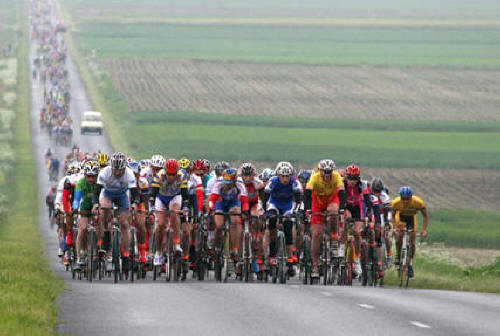
Jacques Bossis Sportive ~ I'm in there somewhere, thinking clearly!
The Message
This is a huge, huge subject and way beyond the remit of my
abilities and this page! I'm afraid you will have to dig
deeper for yourself.
Your route from the pack to the podium and the podium to the top step is pre-determined by your ability to remain calm and think clearly. Most of us have clarity of thought when we're sitting at home, but do we still have it when fifty riders are barreling under the red kite?
Thinking clearly under pressure is a skill and ability that can be learnt. There is a wealth of knowledge out there, all you have to do is find it, distil it down in to what works for you and apply it over the course of a season. You won't always get it right, but when you do, it will change your riding for ever.
Winning is a habit. Your first win is always the hardest, but once it comes, others quickly follow. The experience of winning teaches you something a hundred defeats cannot. So get out there and take your first win, the sooner you do the quicker the others will come.
And remember; some people let things happen, some people make things happen and some people say "what happened".
Only you can decide, and choose, which group you belong to...








